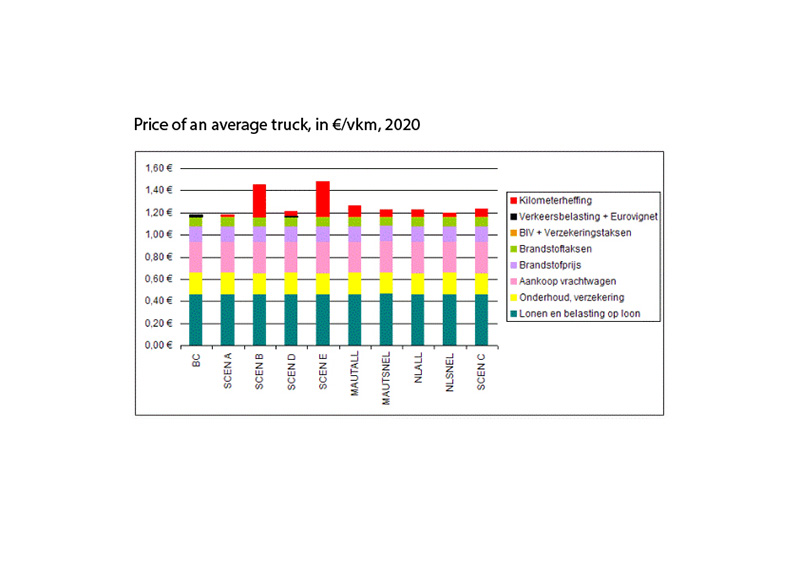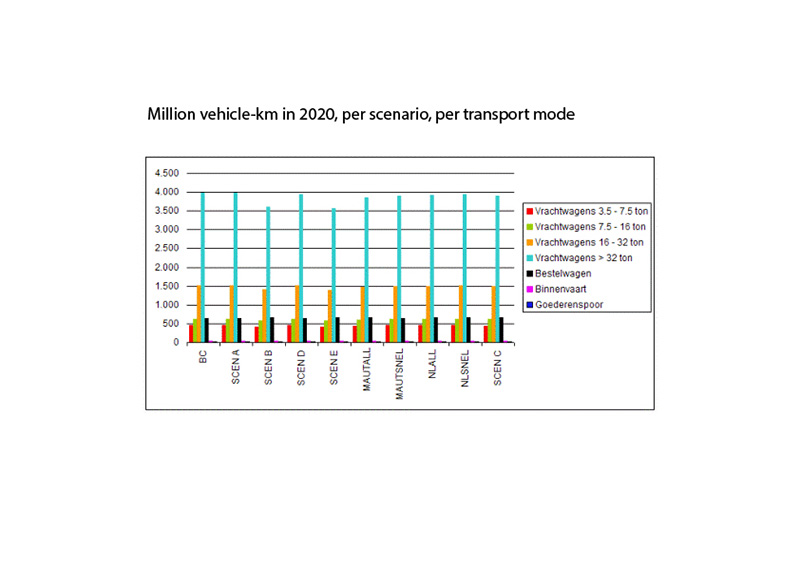Road pricing
07.62 / 07.65 / 08.23 / 08.55
From 2007 to 2008
TML was commissioned by the Flemish government to study the effects of a kilometre charge for trucks in Flanders, running through nine scenarios to evaluate the impact on freight traffic, government revenues, and emissions.
In 2008, TML studied for the Flemish government what the effects would be of a kilometre charge for trucks in Flanders.
Effects on society
A total of nine scenarios were calculated, ranging from a budget-neutral variabilisation of the road tax to a far-reaching differentiated internalisation of all external costs. The effects were then compared with the trend scenario for 2020 and 2030.
The following effects can be expected:
The figure in the right margin (Million vehicle-km in 2020, by scenario, by mode) shows the impact of each scenario on vehicle-km in 2020. It is noticeable that large trucks (above 32 tonnes) account for more than half of the vehicle-km driven. This is because these trucks are mainly used for international traffic and thus drive more hours per day than smaller types.
It is observed that the effect of a kilometre charge on the other modes of transport is relatively small. A lower (scenario A) or higher (scenario E) kilometre charge mainly has an impact on freight traffic itself.
The calculations were carried out using the TREMOVE and ISEEM models.
Technology and implementation aspects
A second background report describes the various technological options, not only for trucks but for road traffic in general.
The report deals with both existing and planned systems. The methodology consisted of two activities: a literature review and several interviews with stakeholders in the field of implementation, execution, and maintenance of road pricing systems.
The study covers
In 2008, TML studied for the Flemish government what the effects would be of a kilometre charge for trucks in Flanders.
Effects on society
A total of nine scenarios were calculated, ranging from a budget-neutral variabilisation of the road tax to a far-reaching differentiated internalisation of all external costs. The effects were then compared with the trend scenario for 2020 and 2030.
The following effects can be expected:
- The price of a kilometre driven by an average truck increases from €1.18 (in 2020) to between €1.18 and €1.50, depending on the scenario chosen.
- Road freight traffic in Flanders falls by 0.75% to 3.4%.
- The decrease in truck kilometres occurs mainly on motorways, even in the scenarios where all roads are charged.
- The Flemish government's revenues increase: there is a decrease of 112 million euros in 2020 due to the abolition of the traffic tax and the Eurovignet, but the kilometre charge brings in 200 to 600 million euros.
- Only a small part (1% to 5% of tonne-kilometres) of the vanished truck kilometres is converted to other modes of transport (rail, inland navigation). The vast majority disappears in shorter trips (destinations) and changed business logistics (stocks).
- The effects on driving speed, passenger traffic, and emissions are very small.
The figure in the right margin (Million vehicle-km in 2020, by scenario, by mode) shows the impact of each scenario on vehicle-km in 2020. It is noticeable that large trucks (above 32 tonnes) account for more than half of the vehicle-km driven. This is because these trucks are mainly used for international traffic and thus drive more hours per day than smaller types.
It is observed that the effect of a kilometre charge on the other modes of transport is relatively small. A lower (scenario A) or higher (scenario E) kilometre charge mainly has an impact on freight traffic itself.
The calculations were carried out using the TREMOVE and ISEEM models.
Technology and implementation aspects
A second background report describes the various technological options, not only for trucks but for road traffic in general.
The report deals with both existing and planned systems. The methodology consisted of two activities: a literature review and several interviews with stakeholders in the field of implementation, execution, and maintenance of road pricing systems.
The study covers
- functional architecture,
- technology and systems,
- operating characteristics,
- system interoperability,
- state-of-the-art of road charging schemes,
- on-board equipment,
- sporadic users,
- additional services,
- the Eurovignette directive,
- capital and operational costs,
- public-private partnerships, and
- enforcement.



